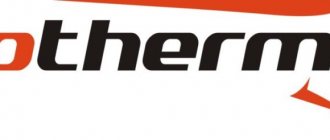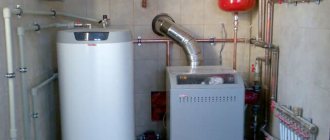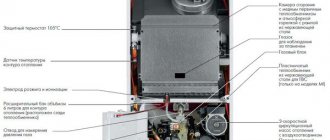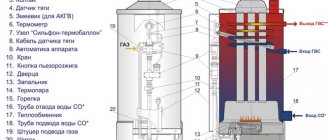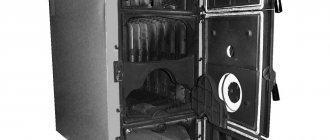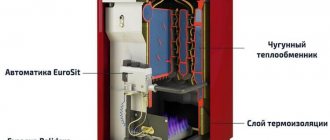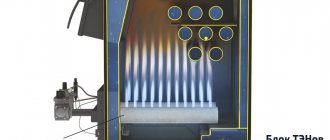Types of gas boilers by purpose
According to their intended purpose, the units are produced as single-circuit and double-circuit. And they differ in the number of installed heat exchangers, capable of independently heating water only for heating or both for heating and hot water supply.
In addition, these units are divided according to the heat exchanger material: cast iron, steel and copper.
The most durable is the cast iron option; it resists corrosion processes well, but is considered fragile and is susceptible to water hammer, especially during cold equipment starts.
Copper is used in wall-mounted boilers and has high thermal conductivity. But it is undesirable when installed in conjunction with aluminum radiators, since a galvanic couple is created that destroys aluminum.
Steel heat exchangers are most often used in floor-standing boilers and are inferior in characteristics to the first two modifications.
Modern boilers are grouped according to the degree of condensation of flue gases into condensing-type boilers or non-condensing units.
Double-circuit boilers
In double-circuit boilers operating on gas fuel, heated water circulates through 2 circuits, one of which is responsible for the functioning of heating, and the second for DHW.
Diagram of a double-circuit boiler
Switching features of a dual-circuit unit:
- Heating. In most modern boilers, the heating circuit starts automatically after the primary temperature sensor gives a signal to the control panel, which increases the gas flow and the speed of the circulation pump for forced coolant circulation systems. The gas is burned in the boiler furnace. Hot flue gases give off their heat through a surface heat exchanger, heating the water, depending on the boiler model, from 75 to 90 °C. A centrifugal pump pumps the heated coolant through the in-house heating system from the boiler to the radiators, and then returns the cooled water to the boiler for a new heating cycle.
- DHW. When the user opens the hot tap on the water supply mixer, the three-way tap on the boiler transfers the coolant from the primary heat exchanger to the secondary one. In this mode, the heating boiler does not work, which is very inconvenient if the family is large. Significant heat consumption for DHW will be required; during this period, the heating system may cool down.
Single-circuit
A single-circuit gas boiler is the simplest in design; it is usually installed in heat supply systems with a small heating area.
They are easy to operate and have the lowest price among gas heating units. Many modern boilers have the design ability to connect an external indirect heating boiler, which is made in the form of a hot water storage tank.
Boiler diagram with one circuit and boiler
At the bottom of the boiler there are special DHW pipes, which are used to connect to an external heat exchanger. This scheme is very effective because it uses the boiler more efficiently.
When the water in the heating system is below the set temperature schedule, the coolant is heated for the heating circuit; when it reaches the desired temperature, the three-way valve switches the coolant to heating water in the storage tank.
At the same time, the DHW water supply will not affect the quality of heating in any way. To reduce heat loss in the heating system, experts advise placing an indirect heating boiler as close as possible to the boiler unit.
Varieties based on operating principle
Gas wall-mounted boilers produced in recent years are complex devices, the efficiency of which designers are trying to increase in every possible way. There are two types of wall-mounted gas boilers, differing from each other in their operating principle.
Bithermal installations
In bithermal boilers, the heating and hot water circuits are different.
The design is represented by two metal tubes inserted into one another. DHW water flows through the inner, smaller diameter, and the outer circuit is intended for coolant used in the heating system. The peculiarity of such a device is that the external circuit heats the internal circuit.
Advantage: Fast heating.
Disadvantages: maximum fuel consumption, operation on excess thrust.
Pre-thermal units
In pre-thermal boilers, the heating circuits for DHW and heating fluid are separate and independent of each other. The tubes are usually copper, located on different sides of the body, and the liquids are heated separately.
Advantages: rational energy consumption, work on natural draft.
Disadvantages: slow heating, formation of limescale, need to use magnetic filters.
Types of gas boilers according to installation method
All gas boilers are grouped according to installation option - floor-mounted and wall-mounted. They all have their advantages and disadvantages; it is important to understand the criteria in which the device will perform best, especially in conditions of shortage of living space.
Wall boilers
These types of gas heating boilers appeared on the climate control market relatively recently, but have already won user sympathy. The modern level of performance of wall-mounted gas units allows them to be used as a mini modular boiler room.
The unit is factory equipped with not only the main but also auxiliary equipment. Typically, its kit includes a circulation pump, two heat exchangers, a fan, a safety group with instrumentation and primary sensors, an air vent and an expansion tank.
These units have a multifunctional mode with 100% automatic combustion process. They are easy to install and have the highest efficiency of up to 92%, since all auxiliary equipment is most carefully matched by the manufacturer to the thermal power of the boiler.
Floor-standing
A floor-standing gas boiler is a traditional option for placing a heating source, which came from a centuries-old Russian stove. These modifications are heavy because, as a rule, they are equipped with a powerful cast-iron heat exchanger. Floor-standing devices are designed for heating houses with a large heating surface.
To increase the thermal power of the heating source, they are equipped with blower fans to organize forced circulation of flue gases.
Depending on the power, the burners are atmospheric up to 80 kW and replaceable inflatable burners with a power of several thousand kW. Such devices are made to be volatile.
Some types of floor-standing units can also be non-volatile, when the heat transfer process is carried out without the need for electrical power, usually these are low-power devices capable of heating an area of up to 200 m2, using natural circulation patterns of the coolant and exhaust gases.
Popular manufacturers of wall-mounted gas boilers
Bosch boilers are considered the most reliable gas appliances in operation.
The range of wall-mounted gas boilers is represented by foreign and domestic products, which differ markedly in price, quality, and reliability. Boiler models from German companies are considered to be of the highest quality:
- Vaillant;
- Bosch;
- Buderus;
- Wolf.
Boilers from Italian manufacturers are more affordable, but also reliable:
- Ariston;
- Beretta;
- Baxi.
Among the domestically produced brands, Neva and ZhMZ are popular. In any case, you should give preference to products from those companies that have been on the market for a long time, provide a long warranty and have a developed network of service centers.
Boilers by combustion chamber type
The next important parameter for classifying types of gas boilers is based on the design of the combustion chamber. They come in open and closed types.
The first ones are simpler and cheaper, but have limitations on the heating area of no more than 250 m2. The latter are more expensive, energy-dependent and safe, since they do not burn oxygen in the house.
With open firebox
An open firebox means that there is a natural intake of combustion air from the room. This is the simplest design of a boiler unit, in which no electricity is needed to organize the combustion process, as well as the arrangement of air ducts and a blower fan. Boilers of this design are usually low-power and heat a living area of no more than 200 m2.
The disadvantage of this type of boiler units is the high requirements for organizing fresh ventilation in the room where it is located. Legislative requirements for ventilation systems for boilers with an open firebox are to ensure 3-fold air exchange through window and door structures.
Otherwise, the air will become dry and will negatively affect the microclimate in the room. In addition, these boilers often have problems due to imperfect smoke exhaust. If the vacuum level in the firebox drops to zero, carbon monoxide can enter the room, which is deadly for others.
Closed chamber boilers
This is a completely new type of smoke exhaust organization in which the firebox has no contact with the internal air in the room. Oxygen is taken to the burner through closed air ducts from the street.
The supply system is forced through a fan. The air enters through a special channel in which the fan is located. This principle is implemented, for example, in the Turkish Vitopend boiler.
The flue gas removal system in it is organized through a coaxial chimney, which is made of the “pipe-in-pipe” type. Exhaust boiler gases are discharged through the internal pipe, and air from the street is drawn in through the annular space by a fan.
The advantage of this system is that its operation does not affect the climate inside the room; installation of complex smoke ventilation ducts that ensure natural circulation is not required. Low space requirements for installation, allowing installation in standard kitchens.
The disadvantages of this design, users most often include their high cost and dependence on electricity.
Specifications
A boiler with an open combustion chamber requires a chimney.
The power range of wall-mounted equipment for thermal energy ranges from 4 to 60 kW. However, the most popular are mounted boilers of small power - from 4 to 25 kW.
The devices differ in the type of burners, which are closed (turbocharged) and open (atmospheric). In the latter, air from the room is used for combustion; exhaust gases are discharged through a chimney with natural draft. In the first, air is taken from the street, gases are discharged into the street. A boiler with a closed burner can be equipped with two pipes or a coaxial pipe - a structure of pipes of different diameters, where the smaller one is inserted into the larger one. They come out of the wall outside. Closed-type boilers are noisy because their operation is ensured by a supply fan, but they are considered safer.
In severe frost, the coaxial pipe can freeze, so its outer part is insulated with a protective casing.
A non-volatile boiler with a manual ignition function can operate without electricity.
Gas attachments are classified according to the principle of operation into traditional and condensing. In traditional boilers, the thermal energy of residual gases is not used in any way. In the condensation units, another heat exchanger is installed to extract heat from the exhaust gases. Combustion products are pumped by a fan. First, the coolant is heated due to the heat of the exhaust gases, then it enters the primary circuit, where it reaches the required temperature. The efficiency of condensing boilers is higher than traditional ones, but the price is also higher, since the device is more complex.
Depending on the type of energy consumed, boilers are:
- Non-volatile - less functional, but more reliable. They work in houses and premises without electricity. Independent of power supply and power surges.
- Volatile - electricity is used as an additional power source. When the power is turned off, the boiler does not work. It is recommended to connect them through a voltage stabilizer.
Volatile boilers are equipped with additional sensors and systems that increase operational safety.
Gas boilers by traction method
The organization of a chimney according to the principle of natural draft is a traditional scheme that has come to heating engineering since ancient times, starting from the hearth and the Russian stove. The movement of flue gases through the channels occurs due to the density difference between the hot flue gases and the cold atmospheric air.
The temperature pressure creates a vacuum in the furnace, due to which air flows from the room into the combustion area in the volume necessary for complete combustion.
Today this method cannot be considered effective; it is usually used in low-power boilers or when the house has an old chimney system.
In addition, it is a source of increased danger, due to the fact that conditions may be created when carbon monoxide begins to penetrate into residential premises.
Therefore, in more advanced gas boilers, a pressurized system is used, provided by a blower fan in a closed combustion space using a coaxial chimney.
For high-power boilers, not only a blower fan is used to supply air to the firebox, but also a smoke exhauster that pumps out boiler gases is installed behind the boiler in front of the chimney.
Gas condensing boilers
Gas condensing boilers are reliable, modern and high-tech devices.
Unlike conventional boilers, which pass combustion products through a heat exchanger grill, condensing boilers transfer their thermal energy to the heat exchanger. Exhaust gases are released into the atmosphere through chimneys, losing some of the heat. Along with the gases, fuel vapor is released, which is formed during combustion, reducing efficiency and taking away some of the energy. This energy is stored by the condensing boiler and transferred to the heating system.
When cooling, steam turns into liquid (condensation), which leads to the release of a certain amount of heat. A special heat exchanger collects condensation and transfers heat to the heating system. During complete combustion of a unit of fuel, heat is generated and released through condensation. This phenomenon is called the higher calorific value of fuel.
Condensing boilers are highly economical. Due to the use of high-tech burners, the preparation of the fuel-air mixture is ensured in the required proportions for a given combustion mode.
This type of boiler can be either wall-mounted or floor-mounted.
For condensing boilers, a heating system is installed with the expectation of a lower coolant temperature. This project takes into account the temperature of the coolant in the return circuit. The temperature cannot exceed 60°C in any climatic conditions.
This type of heating device is the most widespread in Europe. In many countries, it is prohibited to install any gas boilers other than condensing boilers, since these boilers have the lowest emissions of harmful substances and the highest efficiency.
How to choose a boiler
The choice of a heating boiler must be approached responsibly, since it must provide reliable heat supply to the house at the lowest negative outdoor temperatures and operate reliably for at least 10 years.
Several important parameters are taken into account when choosing:
- Determined by the installation method, depending on the free space.
- Determine the types of heat supply systems: heating for a private home or combined for heating and hot water supply.
- Selecting an option for preparing hot water: flow-type in a double-circuit boiler or in a storage boiler in a remote indirectly heated heat exchanger.
- Selecting a unit based on power, using a simple ratio for preliminary calculation: 1 kW per 10 m2 of heated area. For a double-circuit boiler for heating a private house, at least 20% of the power for heating DHW is additionally taken into account. You will also need to introduce correction factors for objects with poor thermal insulation at home.
- Type of heat exchanger material: cast iron, steel and copper.
- Type of coolant movement with natural or forced circulation with an electric pump.
- Type of flue gas removal: natural or forced using a centrifugal fan.
- Volatility and emergency power supply system: stabilizers and uninterruptible power supplies.
- Regulatory and safety system.
Recommendations for selection
Before you buy a wall-mounted gas boiler, you need to determine the required power for heating your home. This parameter is determined at the rate of 1 kW per 10 m² of heated area, with a ceiling height of no more than 3 meters.
Double-circuit units cope well with heating rooms and preparing hot water in households with an area of up to 250 m². In large cottages, the load on the heating system is much greater, so you should use a device with one circuit, and connect special equipment to heat the water.
When installing gas units with natural ventilation, it becomes necessary to connect chimney pipes. Turbocharged and condensing boilers can be installed in any room, subject to compliance with safety standards. They have higher efficiency, but are much more expensive.
Watch a video that talks about the design features of wall-mounted gas boilers.
The best brands of gas boilers
The TOP manufacturers of heating boilers for 2021 operating on gas fuel are compiled according to user preferences.
The most famous and popular manufacturers of units for heating houses with an area of 200-250 m2 include:
- Protherm Cheetah 23 MTV, Slovakia: wall-mounted, single-circuit, energy-dependent, heating output maximum/minimum 24/8.4 kW, modulating burner, electronic control unit, 2-year warranty, price - 40,400 rubles.
- Ferroli Domina F 24 N, Italy: wall-mounted, double-circuit, closed firebox, energy-dependent, heating output maximum/minimum 25.8/10.4 kW, ionization flame control, electronic control unit, 2-year warranty, price - 31,629 rubles.
- Bosch Gaz 6000 W WBN 6000-18C, Germany: wall-mounted, single-circuit, energy-dependent, closed firebox, heating capacity maximum/minimum 20/5.4 kW, modulating burner, electronic control unit, 2-year warranty, price - 46,141 rubles.
- Vaillant turboTEC plus VUW 242/5-5, Germany: wall-mounted, dual-circuit, energy-dependent, heating capacity 20 kW, modulating burner, electronic control unit, 2-year warranty, price - 81,380 rubles.
- Baxi ECO 4s 24F, Italy, wall-mounted, single-circuit, energy-dependent, heating output maximum/minimum 24/9 kW, modulating burner, electronic control unit, 2-year warranty, price - 38,140 rubles.
The market for domestic climate control equipment has enough offers from both Russian and foreign manufacturers, which have their own advantages and disadvantages.
Among domestic boilers for heating private houses, the most popular brands are Lemax, Zota and EVAN.
Review of popular manufacturers and prices
There are many boilers on the market, both foreign and domestic. The most expensive are models from German manufacturers: Wolf, Vaillant, Bosch and Buderus. The products of these companies are famous for their quality. A wide selection of models is offered, which allows you to choose a boiler that meets any needs.
Products from Italian companies - BAXI, Ariston and Beretta - also have excellent characteristics, but are sold at lower prices. Domestic and ZhMZ gas boilers, as well as South Korean Navien, are in high demand. In terms of price-quality ratio, Navien brand equipment is gaining increasing popularity among consumers.
"Ariston"
The products are famous for their high quality workmanship; translated from Greek, “ariston” means “best”.
The company produces four lines of wall-mounted appliances of different modifications:
- ALTEAS X. Premium line, the latest development of the company. Gas units have a built-in WI-FI module that is compatible with the Ariston Net application. The line has three modifications: ALTEAS 24 FF, 30 FF and 35 FF. The numbers in the names of the boilers indicate the rated power for which the devices are designed. The cost of the units is in the price segment from 50,000 to 70,000 rubles.
- Ariston Genus. Premium-class equipment, considered second in functionality after ALTEAS X. The equipment has a liquid crystal display and can be controlled remotely from the control panel. The line is represented by models: Evo - a traditional double-circuit gas appliance with an open or closed combustion chamber and Genus Premium - a more expensive condensing boiler. The power range of all models is from 24 kW to 35 kW. The cost of Ariston Genus boilers ranges from 54,000–72,000 rubles, the price of Premium models can reach 85 thousand rubles.
- Ariston Clas. Units with a large display and AUTO and COMFORT functions. Boilers are the optimal equipment for those who want to save money. Available with a power of 24–28 kW. The average cost is in the range of 25,000–30,000 rubles.
- Ariston Egis. The most common model in Russia. Can operate at temperatures of -50 ºС. Has an electronic control unit. The price of models is from 27,000 to 34,000 rubles.
Prices for wall-mounted gas boilers Ariston
Ariston wall-mounted gas boilers
Watch the video where the Ariston Egis boiler is presented - the most popular model in Russia.
"Baksi"
One of the largest European manufacturers. Produces equipment for heating and domestic hot water supply (hot water supply). The company has representative offices in seven countries: Italy, Great Britain, Spain, France, Germany, Russia, Turkey, as well as in Eastern Europe and the Middle East.
Buyers often prefer the following models of Baksi wall-mounted boilers:
- Baxi Main 4 and Main 5. Only these models have the heating and heating circuits combined in one heat exchanger. Therefore, these boilers are smaller in size compared to other models. Baxi Main 5 is available only with a closed combustion chamber. The power range ranges from 14 to 24 kW. The cost of Main 4 is 20-28,000 rubles, and Main 5 is 25-32,000 rubles.
- Baxi Eco 4 and Baxi Eco Compact. A distinctive feature of these models is the use of an additional stainless steel heat exchanger. Range of powers from 14 to 24 kW. Baxi Eco Compact has small dimensions. Baxi Eco 4 costs from 21,000 to 27,000, and Baxi Eco Compact – from 35,000 to 44,000 rubles
- Baxi 4 Tech and Baxi Eco 4S. Analogues of Baxi Eco 4 and Baxi Eco Compact, but more budget devices. Instead of copper ones, they are equipped with plastic supply tubes, which somewhat reduces the cost of the products.
Ferroli
The well-known Italian company produces a wide range of heating equipment, including wall-mounted units at very reasonable prices.
Ferroli line of gas appliances:
- Diva;
- Domina-N;
- Arena;
- Divatop Micro;
- Divatop-H;
- Divatop Micro-LN;
- Divatop 60;
- Domiproject-D.
The power of each of the models in the list increases by 4 kW: 24, 28, 32 kW. The cost varies from 24,000 to 42,000 rubles.
Prices for wall-mounted gas boilers Ferroli
Ferroli wall-mounted gas boilers
Bosch
A very popular German company whose products are famous for their high quality and functionality.
Produces the following series of wall-mounted gas units:
- BOSCH GAZ 7000 W. Premium wall-mounted gas boilers. The main components of all models in this series are made of brass, without the use of composites. Single-circuit devices: ZSC 24-3 MFK, ZSC 24-3 MFA, ZSC 35-3 MFA with a power of 24 kW and 33.3 kW and costing from 50,000 rubles and 66,000 rubles, respectively. Double-circuit models: ZWC 24-3 MFK, ZWC 28-3 MFK, ZWC 24-3 MFA, ZWC 28-3 MFA, ZWC 35-3 MFA with a power of 24, 28 and 35 kW. Price range - from 55,000 to 68,000 rubles.
- BOSCH GAZ 6000 W. Heating devices in this series are designed and adapted for Russian operating conditions. Single-circuit models: WBN 6000-18 H RN S5700, WBN 6000-24 H RN S5700, WBN 6000-35 H RN S5700 costing from 33,000 to 44,000 rubles. Double-circuit models: WBN 6000-18 WITH RN S5700, WBN 6000-24 WITH RN S5700, WBN 6000-12 WITH RN S5700, WBN 6000-35 WITH RN S5700, sold at prices ranging from 42 to 45 thousand rubles.
- BOSCH GAZ 4000 W. The two-circuit unit ZWA 24-2 K will cost 31,500 rubles. The price of a single-circuit device ZSA 24-2 A is from 35,000 rubles.
- Condens 5000W. High-power wall-mounted condensing units. Models BOSCH ZBR100-3 and BOSCH70-3 with a power of 99.5 kW and 69.5 kW, respectively, cost 244,000 and 219,000 rubles.
Watch the video for a description of the BOSCH GAZ 6000 W gas boiler.
Prices for wall-mounted gas boilers Bosch
Bosch wall-mounted gas boilers
Wolf
The German company has been on the market since 1963 and began with the production of devices for drying hops. Currently, it produces many types of climate control equipment, including a large number of gas heating heat generators of various modifications.
Models of gas units from Wolf:
- GGU-2(K). Traditional boilers. Expensive materials are used in their production, which explains the high cost of the products. Depending on the power of the device and the configuration with various functions, the price ranges from 107,000 to 122,000 rubles.
- GGG-1K. The units are of the classic type, but more budget-friendly. The cost varies from 57 to 65 thousand rubles.
- FGG-K. Traditional appliances, the most budget option. The latest model FGG-K-24 costs from 39,000 rubles.
- GGB-2K, GGB-2, FGB (-K). Condensing boilers. The most economical option in terms of gas consumption. They cost from 116,000 to 300,000 rubles.
Protherm
Gas equipment of the Proterm brand has been produced since 1991, the main production is located in the city of Slavice (Slovakia).
Proterm produces the following brands of wall-mounted boilers:
- "Gepard" - two-circuit devices with a power of 12 and 23 kW. Hot water is heated in a steel plate heat exchanger. Prices are set depending on the region - from 35 to 40 thousand rubles.
- "Jaguar" - two-circuit units in the basic version with a power of 11 and 24 kW. Equipped with a coaxial system. Cost - 30,000-35,000 rubles.
- "Panther" - single-circuit and double-circuit boilers with a capacity of 12, 25, 30 and 35 kW. Price - from 35 to 55 thousand rubles.
- "Tiger" is a coaxial two-circuit device with a power of 12 kW. Hot water is prepared from a built-in 45 liter boiler. It is installed in apartment buildings, country houses, and private properties. The price starts from 56,000 rubles.
- “Lynx” - condensing units with a capacity of 18, 25 and 30 kW, developed by Vaillant Group engineers based on extensive experience in operating boilers operating with hard water and poor quality gas. Price - from 33 thousand to 45 thousand rubles.
"Neva Lux"
The domestic company BaltGaz produces various gas appliances, as well as spare parts and components for them.
Currently BaltGaz produces wall-mounted gas heat generators Neva Lux of the following categories:
- BaltGaz NEVA Turbo - double-circuit convection units with a capacity of 11, 14, 18 and 24 kW. The price, depending on the region, ranges from 28 thousand to 32 thousand rubles.
- BaltGaz SL 11/14/17 series are single-circuit units with the ability to connect them to an indirect heating boiler with a capacity of 11, 14 and 17 kW. Starting price - 17,000-18,000 rubles.
- BaltGaz Turbo S - two-circuit devices with a closed chamber for gas combustion, power - 10, 11, 14, 18, 21 and 24 kW. The price of the units is 30,000-32,000 rubles.
Watch the video showing the new generation Neva Lux boilers.
ZhMZ
OJSC Zhukovsky Machine-Building Plant produces a wide range of gas floor-standing boilers; the production of wall-mounted appliances is not yet included in its program.
Vailant
Vaillant Group is one of the leaders in the production of heating equipment, which is supplied to 60 countries.
Vailant produces 7 model ranges of wall-mounted boilers:
- VAILLANT TURBOFIT VUW - consists of only one double-circuit heating unit Vaillant turboFIT VUW 242/5-2, with a power of 24.7 kW. One of the features of the model is a copper primary heat exchanger. Costs 44,700 rubles.
- VAILANT TURBOTEC PRO VUW. There is only one dual-circuit model Vailant turboTEC pro VUW 242/5-3 with a power of 24 kW. The price of the product is 62,000 rubles.
- VAILANT TURBOTEC PLUS VUW. The series is represented by 5 dual-circuit models. The power of the units increases by 4 kW, starting from 20 kW and ending with 36 kW. Prices - from 69,000 to 100,000 rubles.
- VAILANT TURBOTEC PLUS VU is a series of six single-circuit models. The power line starts from 12 kW and ends at 36 kW. Prices are lower than those of dual-circuit devices, from 56 to 89 thousand rubles.
- VAILLANT ATMOTEC PRO VUW. The series is represented by one dual-circuit model with an open chamber for gas combustion. The power of the unit is 24 kW. You will have to pay 58,000 rubles for the product.
- VAILLANT ATMOTEC PLUS VU - single-circuit units with an open combustion chamber. Presented in three models with 20, 24 and 28 kW of power. Prices range from 47 to 68 thousand rubles.
- VAILLANT ATMOTEC PLUS VUW. Double-circuit boilers with an open combustion chamber. Three models for 20, 24 and 28 kW. They cost from 65,000 to 86,000 rubles.
Buderus
Another German company in the heating industry market. Like all “Germans”, they are distinguished by the high quality of their products. It has its own production in Russia.
Line of wall-mounted boilers from:
- Condensing single- and double-circuit units Logamax plus GB172i. They are distinguished by innovative design, expanded functionality, power range: 20/28, 24, 30, 35, 42 kW. For such a device the buyer will need to pay from 84,000 to 117,000 rubles.
- Single-circuit condensing devices Logamax plus GB162. They provide the possibility of creating a cascade of boilers, have high efficiency, power range: 70, 85, 100 kW. Cost - 200,000-260,000 rubles.
- Condensing devices Logamax plus GB062. Single- and double-circuit devices with a power of 14, 20 and 24 kW. They cost 72,600, 74,700 and 76,000 rubles respectively.
- Gas appliance Buderus Logamax U072. Used for heating and hot water supply, designed for Russian conditions. Power range: 12-18-24-35 kW. Very low-budget models, cost from 34,000 to 50,000 rubles.
- Logamax U052/054. Single- and double-circuit gas heating heat generators Logamax U052 are closed type, and Logamax U054 are with an open chamber for gas combustion. Power range - 24-28 kW. The purchase will cost from 48,000 to 60,000 rubles.
- Logamax U042/044. Logamax U042 double-circuit heating units are equipped with a closed gas combustion chamber and a bithermal heat exchanger. Logamax U044 is an open type boiler with a power of 24 kW. The price is 40,000 and 37,000 rubles, respectively. Read about a wood-burning stove for your home on our website.
Secrets of choosing a floor-standing boiler
Of course, the first thing that draws attention is the power of the gas unit. It is usually suggested to calculate the required power as follows: 1 kW of power per 10 sq.m. This is an average value that does not take into account the height of the ceiling, the number of windows in the room, or thermal insulation. Only a specialist can make the correct calculation.
Some advise purchasing a boiler with a small power reserve. The stock should be small, otherwise equipment will wear out much earlier. For single-circuit boilers, the power reserve is no more than 15%, for double-circuit boilers – no more than 25%.
The most economical boilers include condensing models; they consume fuel 15-30% less than traditional ones. Electronic ignition also saves money. Piezo ignition will lead to excessive gas consumption due to the constant operation of the burner. An electronic burner does not need this, so the cost is of course higher, but the quality and service life are appropriate.
It is necessary to take into account the area of the building: for a small building it is better to purchase a double-circuit boiler, provided that hot water supply is necessary. For large areas, the power of a double-circuit boiler will not be enough and the safety of the system may suffer.
The best material to choose is cast iron or steel. It will last longer. The copper heat exchanger will have to be replaced after some time. More often they choose a unit made of cast iron.
The higher the power, the higher the price. It is considered normal if the efficiency of a floor-standing gas boiler is from 80 to 90%. Condensation models - from 104 to 116% (according to passport data). The higher the efficiency, the less fuel and more efficient operation.
Boilers with automatic control are safer and more convenient. There is no need to control their work. This is a very expensive system. A more budget option involves constant monitoring of work, which is not always convenient.
The size of the boiler, of course, is chosen based on the area of the room where it will stand. The choice is huge. It is important to remember that all additional equipment has easy access.
How to choose a gas boiler for a private home: step-by-step instructions
Not all private houses are connected to a heating and hot water supply system. Many homeowners have to solve this issue on their own. And the best option is a good gas boiler that will provide you with heat and hot water. How to choose the right equipment?
A boiler is a relatively simple device for heating water by burning fuel - in the case of a gas boiler, this is gas. A gas boiler is a burner, a heat exchanger, a pump that circulates water, an outlet for combustion products and a control panel. Externally, the gas boiler is a rectangular body the size of a small refrigerator.
How to choose a gas boiler for a private home and what to pay special attention to when choosing? We invite you to use simple step-by-step instructions that will allow you to determine the general requirements for this equipment.
Determine your expectations from installing a gas boiler: step 1
The first question that needs to be answered when choosing a gas boiler is: “What do you need it for?” Typically, gas boilers are purchased either to solve the heating problem, or for both heating and water heating. If you are only interested in heating, look towards single-circuit boilers. In such boilers, cold water enters through one pipe, is heated and exits through another. These are very simple devices, inexpensive both to purchase and to operate, since they use fuel sparingly.
If you want to get both heating and hot water at once, you will need a double-circuit boiler with two systems - for heating and for supplying hot water. Many similar models are equipped with two heat exchangers, although there are also units with one heat exchanger.
Make a List of Home Features: Step 2
In order to decide which gas boiler is better, you need to know exactly the characteristics of the room. And the most important of them is the area of the house. The required power of the gas boiler depends on the size of the room.
It is quite simple to approximately calculate the required power - to heat 10 square meters, 1 kW of energy is required.
However, if you strictly adhere to this formula, the boiler will constantly have to operate at maximum power, and this can shorten its service life. Therefore, approximately 20% should be added to the resulting figure. That is, for example, to heat a small cottage with an area of 80 square meters, a boiler with a capacity of not 8, but 10 kW is required. For more accurate calculations, indicators such as ceiling height, window size, the presence of additional insulation, climate characteristics and even the location of the house are taken into account - for example, heating a house located on a windy hill requires a more powerful boiler than for heating cottage built in a quiet lowland. Note: If the house is equipped with heated floors, you need to add at least another 20% to the boiler power.
Estimate your budget: step 3
The most significant influence on the cost of a gas boiler is the number of circuits and power. The more powerful the boiler, the more expensive it is, naturally. For example, a high-quality wall-mounted single-circuit boiler from Vaillant with a power of 12 kW will cost you about 60 thousand rubles, and the same model, but with a power of 36 kW - already 90 thousand rubles. On average, the cost of a good household gas boiler is 40–100 thousand rubles.
Select Brand: Step 4
It’s definitely not worth saving on the brand. Of course, you can always find a cheap “no name” gas boiler, but this approach comes with a lot of risk. When choosing a unit, give preference to well-known and time-tested brands. Brands such as Viessmann, Buderus, Vaillant, Ferroli, Western, Protherm, Ariston, Baxi and Mora are definitely trustworthy.
Keep in mind that a well-known brand is not only a guarantee of quality, but also a wide network of service centers, no problems with repairs and spare parts, efficiency and environmental friendliness (since large companies use modern developments that reduce fuel consumption) and a wide selection of models for any needs.
Determine which type of gas boiler is best for your home: step 5
Now that you have decided on the basic characteristics, let's move on to a more detailed selection of the boiler. Let's look at the main points you should pay attention to.
Heat exchanger material . Most often they are made of copper, stainless steel or cast iron. Copper heat exchangers are the most expensive, but they have a lot of undeniable advantages: they are durable, corrosion-resistant, lightweight and at the same time provide excellent heat transfer. Steel heat exchangers are the most widely used. The reason for this popularity is its low cost and resistance to mechanical damage. However, there is also a minus - the risk of corrosion. Cast iron has very good heat transfer and, if used correctly, durability. Its main disadvantage is its heavy weight.
Installation type . For heating and water supply of large houses (from 250–300 square meters), floor-standing boilers are better suited - they are larger and more massive, but also more powerful. Compact wall-mounted boilers are also suitable for small cottages and country houses.
Combustion chamber type . They are open and closed. Boilers with open chambers take air to maintain combustion directly from the room, and a chimney is required to remove combustion products. Such boilers can only be installed in non-residential, specially equipped rooms. Boilers with closed chambers can be installed anywhere, they only need a horizontal chimney with access to the street. But you have to pay for convenience - such boiler models are more expensive than gas boilers with an open combustion chamber.
Study the boiler performance characteristics: step 6
The boiler must not only be efficient, but also easy to use and safe. To evaluate these criteria, pay attention to the electronic component of the selected model.
Modern gas boilers are equipped with a lot of additional options that ensure the comfort and safety of the unit. For example, take an interest in the boiler power control system. The simplest models have only two modes - “on” and “off.” Having purchased such a boiler, you will not be able to select and adjust operating modes. And this is not always convenient - and definitely uneconomical. Boilers that can operate in several modes are much more comfortable to use and save fuel. The best gas boilers are equipped with a smooth regulation system, as well as an automatic adjustment system. Some models can be turned on and off by a timer - for example, during the day, when all the residents are at work, such a boiler will maintain a minimum temperature, and in the evening it will turn on at full power.
Safety is another important consideration. Modern gas boilers from well-known manufacturers are equipped with thermostats that turn off the unit when overheated, pressure relief valves, and a locking system that is triggered in the event of a fire or power outage.
Is it possible to decide on your own which gas boiler to choose for heating a private home? Theoretically, yes, but there are so many subtleties in this matter that it would be safer to entrust this to professionals. Large boiler stores offer not only gas boilers, but also a whole range of services for selection, installation, configuration and maintenance.
Select a store: step 7
“It is most profitable to buy gas boilers in branded stores,” says the expert.
- This provides a number of advantages. Firstly, serious companies always have a wide network of service centers, and all products are given a long-term guarantee, and if the boiler breaks, it will be repaired quickly and with original parts. Secondly, branded stores, such as ours, can offer special purchasing conditions - an additional warranty period or a discount and many other bonuses. You can get acquainted with the assortment, special conditions and promotions on our store’s website.” PS Vaillant is a well-known German brand that has been on the market for over 140 years and is part of the Vaillant Group.
You can view Vaillant boilers on the website www.teplomatica.ru
Boiler characteristics
The gas boiler can be equipped with atmospheric or forced-air burners. Devices with atmospheric burners are sold at a lower price, and they also make less noise during operation. But their disadvantage is low productivity.
Pressurized burners provide the boiler with greater power, often measured in thousands of kilowatts. Also, the burners of heating boilers are single-stage, two-stage and modeled. The latter are the most effective, as they allow you to control fuel consumption.
Heating boilers are divided into two types depending on the type of ignition:
- Devices with electronic ignition. This option is more convenient, since the gases ignite automatically.
- Devices with piezoceramic ignition. When using them, you need to press the corresponding button each time to ignite.
The ignition of these boilers is different.
The boilers are also atmospheric and turbocharged. The first ones work in much the same way as an ordinary stove: air is drawn out of the room and, thanks to natural draft, enters a special chimney. In turbocharged boilers, draft is generated by a built-in fan. In this case, the air is taken not from the room, but from the street.
If you understand well how a gas heating boiler works, then when you come to the store, you can easily show the seller the model you need. But the main thing is to be able to determine the required power of the device. It is this characteristic that must be taken into account first of all in order to achieve normal heating of the home.
Power should be calculated taking into account the volume of the room and the degree of its thermal insulation. Finding out the power of a gas boiler is very simple. To do this, you just need to look at the technical data sheet of the device.
